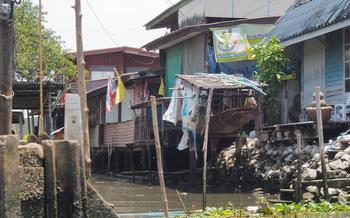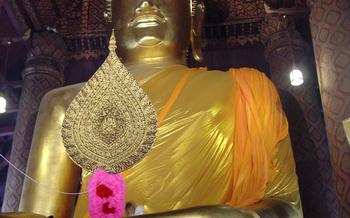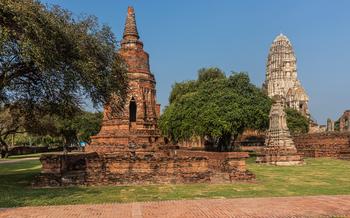
Wat Amparam
- Historical Background
- Religious Importance
- Architectural Beauty
- Stunning Buddha Images
- Serene Ambiance
- Daily Rituals and Ceremonies
- Meditation and Spiritual Retreats
- Cultural Workshops and Classes
- Community Involvement
- Volunteer Opportunities
- Local Cuisine and Street Food
- Transportation and Accessibility
- Accommodation and Where to Stay
- Insider Tip:
Historical Background
Wat Amparam, a beautiful Buddhist temple nestled in the heart of Cha-Am, Thailand, holds a rich historical and cultural significance. Its origins can be traced back to the Ayutthaya period, a time when Thailand flourished as a powerful kingdom. The temple was founded by a revered monk named Luang Pho Daeng in the 18th century. Luang Pho Daeng, known for his wisdom and compassion, sought to create a sacred space where the local community could come together for worship, meditation, and spiritual guidance. Over the years, Wat Amparam has undergone several renovations and expansions, preserving its historical charm while adapting to the changing needs of the community.
The temple's unique architectural features reflect the fusion of traditional Thai and modern design elements. The main prayer hall, adorned with intricate carvings and colorful murals, exudes a sense of awe and reverence. The surrounding grounds are beautifully landscaped with lush gardens, serene ponds, and meticulously maintained Buddha images, creating a peaceful and contemplative environment. Wat Amparam has played a pivotal role in shaping the cultural and spiritual identity of Cha-Am, serving as a center for religious ceremonies, community gatherings, and educational initiatives.
Religious Importance
Wat Amparam holds immense religious significance for Buddhists, serving as a sacred place of worship and meditation. Buddhists from all walks of life flock to the temple to pay homage to the Buddha, offer prayers, and seek spiritual guidance. The temple's serene ambiance and rich Buddhist iconography create an ideal environment for reflection and contemplation.
The temple's central shrine houses a revered Buddha image known as "Luang Phor Dam," which is believed to possess miraculous powers. Devotees often come to the temple to pray to Luang Phor Dam, seeking blessings, protection, and good fortune. The temple also hosts regular meditation sessions led by experienced monks, where visitors can learn and practice various meditation techniques to cultivate inner peace and mindfulness.
Wat Amparam plays a vital role in preserving and promoting Buddhist teachings and practices within the community. Monks residing at the temple offer teachings on Buddhist philosophy, ethics, and meditation to both laypeople and ordained practitioners. The temple also organizes Dharma talks, workshops, and retreats throughout the year, providing opportunities for individuals to deepen their understanding of Buddhism and its profound teachings.
Architectural Beauty
Wat Amparam's architectural design is a testament to the artistry and craftsmanship of traditional Thai architecture. The temple's main structure, the ubosot, is a rectangular building with a triple-tiered roof. The roof is adorned with intricate carvings and colorful ceramic tiles that depict scenes from Buddhist mythology. The exterior walls of the ubosot are decorated with delicate stucco reliefs that depict the life of Buddha and other important figures from Thai history.
The temple's viharn, or assembly hall, is another striking example of Thai architecture. It features a wide open space with a high ceiling supported by massive wooden pillars. The walls of the viharn are adorned with colorful murals that depict scenes from Thai history and Buddhist legends.
The temple grounds are also home to a number of other structures, including a bell tower, a drum tower, and a library. Each of these structures is beautifully decorated with traditional Thai motifs, making Wat Amparam a true masterpiece of Thai architecture.
Stunning Buddha Images
Wat Amparam is home to a collection of awe-inspiring Buddha images that captivate visitors with their intricate details and serene expressions. The main Buddha image, known as Luang Pho Amparan, is a majestic golden statue that exudes an air of peace and tranquility. It is believed to date back to the Ayutthaya period and is highly revered by the local community. Other notable Buddha images include a reclining Buddha, a standing Buddha, and a meditating Buddha, each showcasing unique styles and postures. These sacred images represent the teachings of Buddhism and serve as objects of devotion for worshippers. The reverence and devotion that the Buddha images inspire among visitors is palpable, creating a deeply spiritual atmosphere within the temple.
Serene Ambiance
Wat Amparam exudes a palpable aura of peace and serenity, inviting visitors to immerse themselves in its tranquil atmosphere. The temple is surrounded by lush gardens, where the gentle rustling of leaves and the sweet fragrance of flowers create a soothing ambiance. As you step into the temple grounds, the hustle and bustle of the outside world fades away, replaced by a sense of calm and tranquility. The temple's serene surroundings provide the perfect setting for meditation, contemplation, and spiritual reflection. Visitors are encouraged to maintain silence and respect the sacredness of the temple, allowing themselves to be enveloped by the temple's peaceful and harmonious energy.
Daily Rituals and Ceremonies
At Wat Amparam, daily rituals and ceremonies play a crucial role in upholding the temple's spiritual significance and fostering a sense of community among its devotees. These rituals, deeply rooted in Buddhist traditions, are performed by monks and laypeople throughout the day, offering visitors a glimpse into the vibrant religious life of the temple.
One of the most important daily rituals is the morning alms-giving ceremony, known as Tak Bat. Devout Buddhists gather at the temple before sunrise, bearing offerings of food and other necessities to the resident monks. This act of generosity is believed to bring merit to the donors and cultivate compassion within the community. Visitors are welcome to observe this sacred ritual from a respectful distance, witnessing the monks' silent procession as they receive the offerings.
Throughout the day, monks engage in various meditation and chanting sessions within the temple's serene meditation hall. These practices, central to Buddhist teachings, promote inner peace, mindfulness, and spiritual growth. Visitors seeking a deeper connection with their spiritual side can join these sessions and learn from the wisdom of the resident monks.
In the evenings, Wat Amparam hosts regular evening prayers and chanting sessions, where devotees gather to recite sacred Buddhist scriptures and pay homage to the Buddha. These sessions create a harmonious and uplifting atmosphere, allowing participants to reflect on their spiritual journey and connect with the temple's sacred energy.
Meditation and Spiritual Retreats
Wat Amparam offers a unique opportunity for visitors to immerse themselves in meditation and spiritual practices. The temple provides a tranquil and serene environment conducive to self-reflection and inner peace. Visitors can participate in guided meditation sessions led by experienced monks, who share their knowledge and insights into Buddhist teachings and mindfulness practices. These sessions are suitable for both beginners and experienced meditators, offering a chance to learn and deepen one's understanding of meditation.
In addition to meditation sessions, Wat Amparam also offers spiritual retreats for those seeking a more immersive experience. These retreats typically last for several days and include daily meditation sessions, teachings on Buddhist philosophy, and guidance on spiritual development. Participants have the opportunity to learn from experienced teachers, engage in group discussions, and practice mindfulness in a supportive and nurturing environment.
Whether you are a seasoned meditator or new to the practice, Wat Amparam provides a welcoming and supportive space to explore your spiritual journey. The temple's serene atmosphere, knowledgeable teachers, and diverse programs make it an ideal destination for those seeking inner peace and spiritual growth.
Cultural Workshops and Classes
Wat Amparam offers a variety of cultural workshops and classes that provide visitors with hands-on experiences and insights into traditional Thai culture. These workshops are a wonderful way to learn new skills, connect with the local community, and gain a deeper appreciation for Thailand's rich cultural heritage.
One of the most popular workshops is traditional Thai dance. Visitors can learn the graceful movements and rhythmic steps of this elegant art form, which is an integral part of Thai culture. Classes are taught by experienced instructors who patiently guide students through the basics, from simple steps to more complex choreography.
Cooking classes are another popular option for visitors who want to learn how to prepare delicious Thai dishes. Participants can choose from a variety of classes, each focusing on different regional cuisines or specific dishes. Students will learn how to select fresh ingredients, prepare traditional sauces and pastes, and cook authentic Thai dishes using traditional techniques.
Meditation classes are also offered at Wat Amparam, providing visitors with an opportunity to learn the basics of mindfulness and meditation practices. These classes are suitable for both beginners and experienced practitioners and are conducted by experienced monks or meditation teachers. Participants will learn how to focus their minds, cultivate inner peace, and develop a deeper sense of self-awareness and compassion.
In addition to these workshops, Wat Amparam also offers classes in other traditional Thai arts and crafts, such as flower arrangement, fruit carving, and umbrella making. These classes are a great way to learn new skills, create unique souvenirs, and support local artisans.
The cultural workshops and classes at Wat Amparam are open to visitors of all ages and skill levels. They are a fantastic way to immerse yourself in Thai culture, learn new skills, and create lasting memories of your time in Cha-Am.
To register for a workshop or class, visitors can contact the temple directly or book online. Advance booking is recommended, especially for popular workshops and classes.
Community Involvement
Wat Amparam actively engages in community activities and social welfare initiatives, playing a vital role in supporting and assisting the local community. The temple's commitment to community development is evident through various programs and initiatives it undertakes.
One significant aspect of Wat Amparam's community involvement is its educational programs. The temple offers classes and workshops on traditional Thai culture, language, and history, fostering a sense of cultural identity and pride among the local youth. These programs aim to preserve and promote Thai cultural heritage while providing educational opportunities to the community's younger generation.
In addition to its educational initiatives, Wat Amparam also engages in charitable activities, providing support to those in need. The temple organizes food drives, clothing donations, and financial assistance to help underprivileged families and individuals in the community. Through these charitable efforts, Wat Amparam demonstrates its commitment to social welfare and community well-being.
Visitors to Wat Amparam have the opportunity to get involved in these community activities and make a positive impact. By volunteering their time or contributing to the temple's charitable initiatives, visitors can gain valuable cultural insights, connect with the local community, and give back to those in need. Volunteering at Wat Amparam is a rewarding experience that allows visitors to immerse themselves in the temple's spiritual and cultural traditions while making a meaningful contribution to the community.
Volunteer Opportunities
Wat Amparam offers a unique opportunity for visitors to immerse themselves in the local culture and contribute to the community through volunteering. The temple welcomes volunteers from all walks of life who are eager to learn about Buddhism, Thai culture, and community service.
Volunteer tasks may include assisting with temple maintenance, gardening, teaching English to monks, or participating in community outreach programs. Volunteers can also assist with special events and festivals, such as the annual temple fair or the Songkran water festival.
Volunteering at Wat Amparam is a rewarding experience that allows visitors to give back to the community while gaining valuable cultural insights. It is a great way to connect with the local people, learn about their way of life, and make a positive impact on the temple and the surrounding community.
To apply for a volunteer position, interested individuals can contact the temple directly or through a reputable volunteer organization. It is important to note that volunteers are expected to be respectful of the temple's customs and traditions, and to dress appropriately when working in the temple grounds.
Local Cuisine and Street Food
Indulge in a culinary adventure as you explore the vibrant food scene surrounding Wat Amparam. Cha-Am is renowned for its delectable Thai cuisine, offering an array of flavors and culinary delights. Tantalize your taste buds with must-try dishes like Pad Thai, a stir-fried rice noodle dish with shrimp, chicken, or tofu, and Tom Yum Goong, a spicy and sour soup with prawns. Don't miss the opportunity to sample Som Tum, a refreshing green papaya salad, and Khao Pad Sapparot, fragrant pineapple fried rice.
Venture into the bustling streets and discover hidden gems where local food stalls serve up authentic Thai delicacies. Try Gaeng Daeng, a red curry with chicken or beef, and Massaman Curry, a rich and flavorful curry with coconut milk and peanuts. For a sweet treat, indulge in Khao Neeo Mamuang, sticky rice with ripe mango, or Sangkaya Fakthong, a coconut custard served with fresh bread.
Embrace the vibrant atmosphere of Cha-Am's night market, where you can find an array of street food stalls offering a diverse selection of Thai dishes. Enjoy the convenience of having everything in one place, from grilled meats and seafood to fresh fruits and traditional desserts.
Remember to be adventurous and embrace the unique flavors of Thai cuisine. Don't be afraid to try new dishes and ask locals for recommendations. With its rich culinary heritage, Cha-Am is a foodie's paradise, offering an unforgettable gastronomic experience for every visitor.
Transportation and Accessibility
Reaching Wat Amparam is a breeze, whether you're starting from Bangkok or other major cities in Thailand. Public transportation is readily available, with buses and trains offering affordable and convenient options. The journey typically takes around 3-4 hours, depending on your starting point. Once you arrive in Cha-Am, local taxis or tuk-tuks can whisk you to the temple's doorstep for a nominal fee.
To optimize your visit, plan your trip for a weekday or early morning to avoid the weekend crowds. This will allow you to immerse yourself in the temple's tranquility and fully appreciate its spiritual essence.
Accommodation and Where to Stay
When planning your visit to Wat Amparam, you'll want to consider your accommodation options. There are several hotels and resorts to choose from in Cha-Am, ranging from budget-friendly guesthouses to luxurious beachfront properties.
If you're looking for a convenient and affordable option, several guesthouses are located within walking distance of the temple. These guesthouses typically offer basic rooms with air conditioning and private bathrooms.
For a more comfortable stay, you can opt for one of the many resorts in Cha-Am. These resorts offer a range of amenities, including swimming pools, restaurants, and spas. Some resorts even have direct access to the beach, making it easy to enjoy the sun and sand.
When choosing your accommodation, consider your budget, travel style, and the distance you're willing to travel to the temple. If you're looking to fully immerse yourself in the local culture, staying in a guesthouse near the temple is a great option. However, if you prefer a more luxurious experience, one of the many resorts in Cha-Am may be a better choice.
No matter where you choose to stay, be sure to book your accommodation in advance, especially if you're visiting during peak season.
Insider Tip:
For an unforgettable experience, visit Wat Amparam during the annual temple fair, usually held in November or December. Immerse yourself in the vibrant atmosphere as locals and visitors gather for a lively celebration filled with traditional music, dance performances, and delicious food stalls. Participate in merit-making activities and receive blessings from the monks. This is a unique opportunity to witness the temple's vibrant community spirit and connect with the local culture on a deeper level. Remember to dress respectfully and observe local customs during your visit to the temple.



